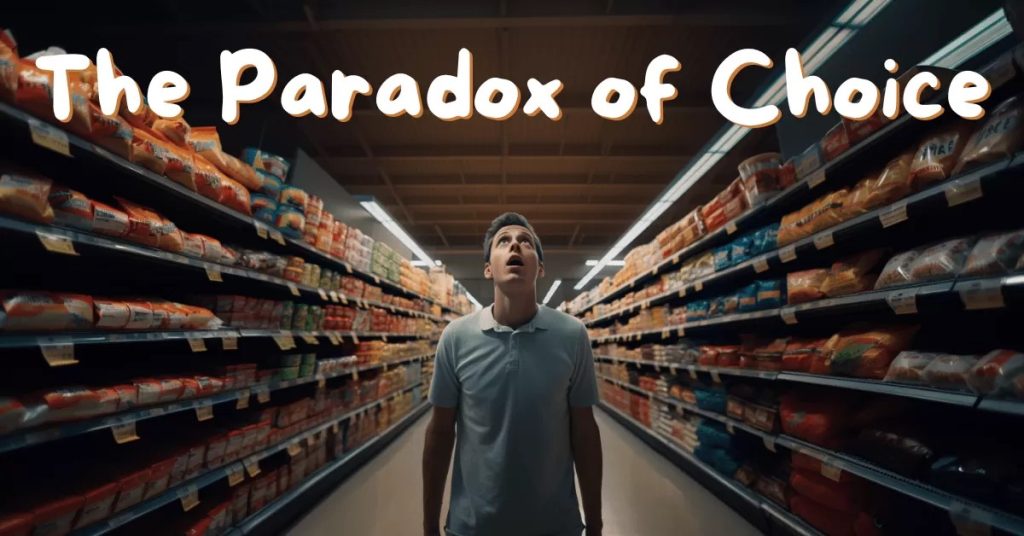In today’s consumer-driven world, people have more choices than ever before. From the cereal aisle at the grocery store to the endless options available online, choice is a fundamental aspect of modern life. However, having too many choices can sometimes lead to anxiety, indecision, and dissatisfaction. This phenomenon is known as the Paradox of Choice. It’s a concept that challenges the assumption that more options always lead to better decisions. By understanding the Paradox of Choice, businesses and individuals can navigate the complexities of decision-making and create more fulfilling experiences.
What is the Paradox of Choice?
The Paradox of Choice refers to the counterintuitive situation where having more options can actually lead to worse outcomes. While it might seem logical that more choices should empower consumers, too many options can overwhelm them. This overwhelm can cause paralysis. Overwhelmed consumers often struggle to make a decision or feel less satisfied with the choices they do make. The Paradox of Choice suggests that beyond a certain point, the abundance of options can lead to decreased happiness and increased anxiety.
Psychologist Barry Schwartz popularized the concept in his book The Paradox of Choice: Why More Is Less. Schwartz argues that while some choice is essential for well-being, too much choice can have negative consequences. Instead of feeling liberated by the multitude of options, consumers may experience doubt, regret, and a fear of making the wrong choice. This paradox highlights the complexity of decision-making in a world saturated with choices.
The Psychology Behind the Paradox of Choice
The Paradox of Choice is rooted in several psychological principles, including decision fatigue, regret, and the need for cognitive closure. One key factor is decision fatigue, which occurs when the mental energy required to make decisions becomes depleted. The more choices a person has to make, the more exhausting the process becomes. This fatigue can lead to poorer decisions or the avoidance of decision-making altogether.
Another psychological element at play is the fear of regret. When faced with numerous options, individuals may worry about making the wrong choice and missing out on better alternatives. This fear can prevent them from committing to a decision, leading to feelings of anxiety and dissatisfaction. The Paradox of Choice intensifies this fear, as the more options there are, the greater the potential for regret.
Additionally, the Paradox of Choice is linked to the need for cognitive closure. This is the desire for a firm answer to a question and an aversion to ambiguity. When consumers are presented with too many choices, it can delay the decision-making process. This is because it makes them struggle to find the “perfect” option. This search for perfection often leads to frustration and disappointment, as the ideal choice may not exist.
The concept of opportunity cost also contributes to the Paradox of Choice. When choosing one option, individuals must forgo others, leading to a sense of loss or missed opportunity. The more choices available, the greater the perceived opportunity cost, which can diminish satisfaction with the chosen option.
Practical Implications of the Paradox of Choice in Marketing
Understanding the Paradox of Choice has significant implications for marketing and business strategy. Companies that recognize the pitfalls of overwhelming consumers with too many options can design better experiences. This will lead to higher customer satisfaction and loyalty. One practical application is the simplification of product offerings. By curating a more focused selection of products or services, businesses can reduce decision fatigue. This makes the purchasing process easier and more enjoyable for consumers.
Another approach is the use of guided decision-making tools, such as filters, quizzes, or personalized recommendations. These tools help narrow down choices based on individual preferences, making the decision process less overwhelming. For example, an e-commerce site might use a quiz to help customers find the right product based on their needs. This reduces the number of options to a manageable level.
Additionally, businesses can implement strategies to alleviate the fear of regret by offering satisfaction guarantees. Easy return policies and trial periods also help. These strategies reduce the perceived risk of making a wrong choice. This gives consumers the confidence to make decisions without the burden of potential regret.
In pricing strategies, businesses can also leverage the Paradox of Choice by offering tiered pricing models with clear distinctions between options. By providing a small, medium, and large option (often known as “good, better, best”), companies can simplify the decision-making process while still offering enough variety to appeal to different customer segments. This approach reduces the cognitive load on consumers, making it easier for them to choose the option that best fits their needs.
The Impact of the Paradox of Choice on Consumer Behavior
The Paradox of Choice has a profound impact on consumer behavior, influencing how people shop, make decisions, and experience satisfaction. One of the most notable effects is the potential for decreased satisfaction with decisions. When consumers are overwhelmed by too many choices, they may feel less confident in their decision and more likely to second-guess themselves. This can lead to lower levels of satisfaction and a diminished sense of well-being.
Moreover, the Paradox of Choice can lead to decision paralysis, where individuals are unable to make a choice at all. Faced with too many options, consumers may become so overwhelmed that they postpone the decision or opt for the default choice, even if it is not the best one. This paralysis can result in missed opportunities and a sense of frustration.
The Paradox of Choice also affects consumer loyalty. When customers feel overwhelmed by too many options, they may be less likely to return to a brand or store. Simplifying the decision-making process and providing a more curated experience can enhance customer loyalty by making shopping more enjoyable and less stressful.
Additionally, the Paradox of Choice can influence purchasing patterns. For example, consumers might choose to buy less when confronted with too many options, as the cognitive effort required to make decisions becomes too taxing. Alternatively, they might stick to familiar brands or products to avoid the complexity of choosing from a wide array of options. Understanding these behaviors can help businesses tailor their offerings to meet consumer needs more effectively.
Overcoming the Paradox of Choice for Better Decision-Making
While the Paradox of Choice can be challenging, there are strategies that individuals and businesses can use to overcome its negative effects and make better decisions. One approach is to set clear criteria for decision-making. By defining what is most important in a choice, individuals can narrow down options and focus on what truly matters. This clarity reduces the cognitive load and makes the decision-making process more manageable.
Another strategy is to limit the number of options considered. Instead of trying to evaluate every possible choice, individuals can select a few top options that meet their criteria and compare those. This approach simplifies the decision-making process and reduces the likelihood of becoming overwhelmed.
Businesses can also help consumers overcome the Paradox of Choice by offering decision aids, such as expert reviews, customer testimonials, or side-by-side comparisons. These tools provide valuable information that can guide consumers toward a decision, reducing the uncertainty and anxiety associated with too many choices.
Additionally, practicing mindfulness and focusing on the present moment can help individuals make more satisfying decisions. By paying attention to how they feel during the decision-making process, individuals can recognize when they are becoming overwhelmed and take steps to simplify their choices.
Finally, businesses can create a sense of ease and confidence in the decision-making process by communicating the value and benefits of their products clearly. Providing reassurance that customers are making a good choice can alleviate the fear of regret and enhance overall satisfaction.
The Ethical Considerations of Managing Choice
While managing choice effectively can lead to better outcomes, it also raises ethical considerations. Businesses must be careful not to manipulate consumer behavior by overly restricting choice or using psychological tactics that exploit consumer vulnerabilities. Providing a balanced selection that meets consumer needs while avoiding overwhelming them is key to maintaining trust and fostering positive relationships.
Additionally, businesses should be transparent about the choices they offer and the criteria used to recommend or highlight certain options. Transparency builds trust and empowers consumers to make informed decisions that align with their values and preferences.
In summary, while the Paradox of Choice presents challenges, understanding its impact and implementing strategies to manage it can lead to more satisfying and fulfilling decision-making experiences. Both businesses and individuals can benefit from recognizing the limitations of too many choices and focusing on what truly matters. By doing so, they can navigate the complexities of modern life with greater ease and confidence.
The Paradox of Choice is a powerful concept that reveals the complexities of decision-making in a world filled with endless options. While choice is essential for freedom and autonomy, too much choice can lead to overwhelm, dissatisfaction, and decision paralysis. By understanding the Paradox of Choice and implementing strategies to manage it, both businesses and individuals can create more positive and fulfilling experiences. Whether it’s simplifying product offerings, providing decision aids, or setting clear criteria for choices, recognizing the limits of choice can lead to better decisions and greater satisfaction.


